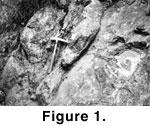THE ORTHOCERATITE LIMESTONE
 The Orthoceratite Limestone of south-western Sardinia clearly suffered compaction after the deposition. Furthermore, the tectonic stresses applied to this region during the Caledonian and Hercynian orogenies further deformed these originally stratified sedimentary deposits to the extent that this rock body now forms a series of rounded-edge, lens-shaped structures
(Fig. 1) with a maximum thickness of several
decimetres. Gnoli et
al. (1979, p. 408, Fig. 2) demonstrated that these bodies clearly preserved fine horizontal 'plane-parallel' laminations of the original sediment, abruptly interrupted at the edges of each 'lens'. The rounding of these lenses could be due either to weathering or to tectonic lamination. There is also a possibility that aspects of these 'lenses' formed as a result of deposition on an undulating sea bottom and that this original geometry was later accentuated by the tectonic deformation.
The Orthoceratite Limestone of south-western Sardinia clearly suffered compaction after the deposition. Furthermore, the tectonic stresses applied to this region during the Caledonian and Hercynian orogenies further deformed these originally stratified sedimentary deposits to the extent that this rock body now forms a series of rounded-edge, lens-shaped structures
(Fig. 1) with a maximum thickness of several
decimetres. Gnoli et
al. (1979, p. 408, Fig. 2) demonstrated that these bodies clearly preserved fine horizontal 'plane-parallel' laminations of the original sediment, abruptly interrupted at the edges of each 'lens'. The rounding of these lenses could be due either to weathering or to tectonic lamination. There is also a possibility that aspects of these 'lenses' formed as a result of deposition on an undulating sea bottom and that this original geometry was later accentuated by the tectonic deformation.
While several classic analyses of compaction of sedimentary limestone bodies are well known (e. g. Meyers 1980 and references therein), these have not taken advantage of the information to be gained by geometrical studies of associated fossil deformations. To correctly estimate the amount of post-depositional thickness reduction experienced by these deposits, a reference datum derived from an original synsedimentary geometry is required. Reference geometries of this type can be obtained from these Sardinian deposits via analysis of the fossil orthoconic cephalopod visors and body chambers that occur in these sediments in coquina-like profusion
(Serpagli and Gnoli, 1977; Gnoli, 1987,
1990, 1994,
1996; Gnoli and Kiselev,
1995).
In order to precisely define the age of the examined faunas, a small sample was processed for conodonts, using the conventional acetic-acid technique (Stone 1987). The conodont fauna is very rich (over 250
elements/kg) and well preserved. In addition, a few phyllocarid gnathal lobes have been recovered. Recovered conodont elements belong to Kockelella variabilis variabilis, K. v. ichnusae, K. absidata absidata, Ozarkodina excavata excavata and Oz. exc. inflata. Based on this fauna, the sample can be dated
as the upper Gorstian in terms of the Sardinian Conodont Zonation
(Corradini and Serpagli, 1999), and referred to the Oz. exc. hamata Zone or to the lower part of the A. ploeckensis Zone.

 The Orthoceratite Limestone of south-western Sardinia clearly suffered compaction after the deposition. Furthermore, the tectonic stresses applied to this region during the Caledonian and Hercynian orogenies further deformed these originally stratified sedimentary deposits to the extent that this rock body now forms a series of rounded-edge, lens-shaped structures
(Fig. 1) with a maximum thickness of several
decimetres. Gnoli et
al. (1979, p. 408, Fig. 2) demonstrated that these bodies clearly preserved fine horizontal 'plane-parallel' laminations of the original sediment, abruptly interrupted at the edges of each 'lens'. The rounding of these lenses could be due either to weathering or to tectonic lamination. There is also a possibility that aspects of these 'lenses' formed as a result of deposition on an undulating sea bottom and that this original geometry was later accentuated by the tectonic deformation.
The Orthoceratite Limestone of south-western Sardinia clearly suffered compaction after the deposition. Furthermore, the tectonic stresses applied to this region during the Caledonian and Hercynian orogenies further deformed these originally stratified sedimentary deposits to the extent that this rock body now forms a series of rounded-edge, lens-shaped structures
(Fig. 1) with a maximum thickness of several
decimetres. Gnoli et
al. (1979, p. 408, Fig. 2) demonstrated that these bodies clearly preserved fine horizontal 'plane-parallel' laminations of the original sediment, abruptly interrupted at the edges of each 'lens'. The rounding of these lenses could be due either to weathering or to tectonic lamination. There is also a possibility that aspects of these 'lenses' formed as a result of deposition on an undulating sea bottom and that this original geometry was later accentuated by the tectonic deformation.